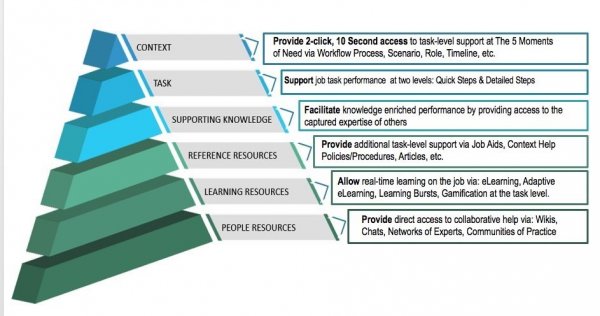There are many threats to an organization's ability to perform its work profitably. Wasted work time is a big one. And in the realm of wasted work time, there are key areas where workflow learning can provide significant relief. In a recent article, How Workflow Learning Can Power the Classroom, I describe how, on the average, half of the work stoppage associated with traditional learning events is unnecessary—in other words, a waste, and how workflow learning can eliminate that waste.
A second, huge area of waste is the time employees spend trying to figure out how to perform their jobs including searching for the right information resources needed to close that gap.
Regarding this, here are two questions every organization interested in profitability needs to answer:
- How much work time are our employees spending trying to figure out how to do their jobs?
- To what degree are they spinning their wheels looking for the information they need rather than efficiently moving the work forward with 2-click access to just what’s needed at the moment of need?
The good news is 5 MoN Workflow Learning Solutions, when properly designed and implemented, can eradicate most of this wasted work time. Although traditional knowledge management efforts can play a key role, they are generally missing a vital approach that directly attacks this huge threat of wasted worktime. This approach is part of the 5 Moments of Need “EnABLE” methodology. It’s called the “Performance Support Pyramid.”
This Pyramid provides a framework for supporting job performance via an EPSS (Embedded Performance Support Solution.) An EPSS serves as a Digital Coach that performers can access anytime, anywhere, to help provide them 2-click access to just what they need, at their moment of need.
The Performance Support Pyramid is a resource management hierarchy that addresses the evolving information requirements of employees as they perform each specific job task. The following graphic shows this layered approach describing how each layer can provide fingertip access to a specific category of information resources that employees need as they perform their work.

The top of the pyramid addresses the need to provide employees contextual access to the cascading levels of support resources that follow. The workflow process is the primary context for accessing all job-task level support. As noted, there can be other contextual ways to access resources, as well.
As you study the pyramid above, note that at the moment of Apply, performers need contextual access, within 2 clicks, to specific step guidiance for doing what needs to be done, represented here as the “Task” level. Once performers have accessed the steps for a given task, they may also need access to all the resources that support the effective completion of that task found in the layers that follow. The Pyramid framework provides a systematic approach for accessing four categories of information resources:
- Supporting Knowledge
- Reference Resources
- Learning Resources
- People Resources
So, here’s how the Pyramid works.
The performer accesses a high-level view of the steps (Quick-steps) for a specific task via a work-flow map.
Once performers access a high-level view of the steps for a specific task (within two clicks), they need an optional single-click access to detailed instructions for performing that task.
If, performers know what to do, but lack specific knowledge needed to support their performance, then they can, with another click, access resources that reinforce the knowledge needed (i.e., Supporting Knowledge.)
Or, if performers need to access specific “Reference Resources” to support them as they complete the steps of the task (such as tools, templates, policy statements, job-aids, answers to frequently asked questions, etc.,) then a different click would provide immediate access to a listing of these kinds of reference resources.
And so it goes down the pyramid, accessing “Learning Resources” and “People resources” specific to each job task. Each cascading layer represents the possibility of a greater level of work interruption. But, at the moments of “Apply,” “Solve,” “Change,” and “Learn New & More,” there isn’t the luxury of time to search through endless hits offered up by search engines, wander through websites, or dive down into a learning management system to find, and then plow through, an e-learning module to get to just what is needed. Performers require intuitive, immediate access to the steps of any job task with two clicks. Then, according to the specific “Moment of Need” they must be able to get to the other resources shown in the Pyramid and then translate those resources into performance within ten seconds. This “Pyramid” approach provides a consistent framework for accessing different types of resources. It makes possible immediate, tailored access to “Just what’s needed, at the moment of need, to get the job done with a minimum of wasted effort.
An organization is competent to the degree its people individually and collectively succeed at their work. Information chaos threatens any organization’s capacity to become and remain competent in the work they do. The PS Pyramid alleviates all of this. It systematically orchestrates information resources in a way that addresses the dynamic information requirements of people as they do their work. Our work is to make sure this happens and that we do so as efficiently as possible. This layered approach should guide how every organization provides fingertip access to the specific information resources performers need to do their work.
More resources on The 5 Moments of Need.
Copyright © 2022 by APPLY Synergies, LLC
All Rights Reserved.

No comments:
Post a Comment
Note: Only a member of this blog may post a comment.